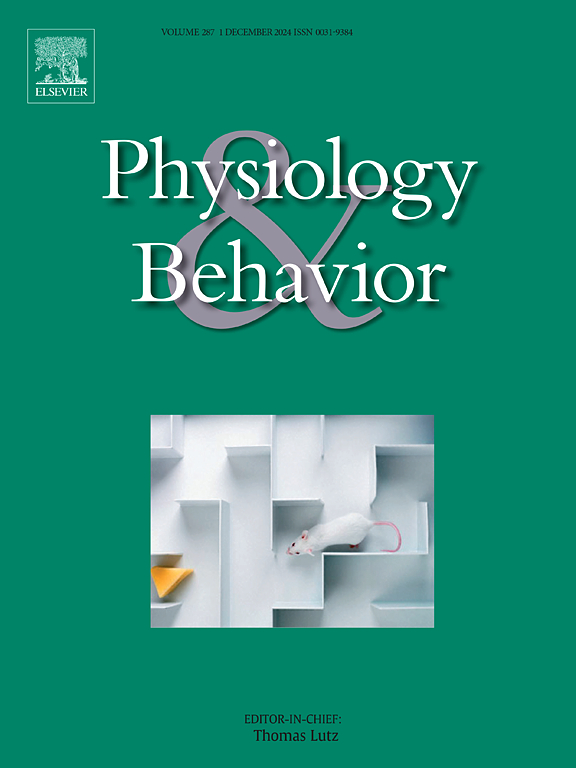味觉线索对雌雄大鼠乙醇反应的影响
IF 2.4
3区 医学
Q2 BEHAVIORAL SCIENCES
引用次数: 0
摘要
苦味刺激,如乙醇(EtOH),是天生避免的,但感官驱动行为的可变性可能导致乙醇摄入量的差异。实验1的设计是为了验证乙醇的味道品质存在性别差异的假设。雌性和雄性大鼠分别给予5%或10%的EtOH,然后给予(i.p) LiCl以诱导内脏不适,或生理盐水作为对照。条件回避的泛化在一个简短的味觉测试中被评估(10-s试验;其中,水、0.03和0.3 mM蔗糖(“甜”)、0.03和0.3 mM奎宁(“苦”)和蔗糖-奎宁混合物随机分组,不进行替换。对乙醇的条件回避推广到蔗糖和蔗糖-奎宁混合物。在实验2中,在给药(i.p)生理盐水、0.1或1.0 mg/kg纳曲酮(一种阿片受体拮抗剂)后,测量了大鼠对一系列乙醇浓度(1 - 32%)的无条件舔反应。与生理盐水相比,纳曲酮降低了两性开始的试验,但降低了32%乙醇仅对男性的反应。总之,这些发现表明乙醇的口服定性特征是可比的,蔗糖样成分在两性中最显著。阿片能信号驱动对乙醇行为的食欲成分在女性和男性中是相似的,但在完成行为的某些成分中是不同的。因此,对乙醇的反应的性别差异似乎不是主要由乙醇的定性成分的可变性驱动的,乙醇有助于摄入行为的完善方面,而更可能是由奖励相关的信号传导驱动的。本文章由计算机程序翻译,如有差异,请以英文原文为准。
The contributions of taste cues to ethanol responses in female and male rats
Bitter-tasting stimuli, like ethanol (EtOH), are innately avoided yet variability in orosensory-driven behaviors may contribute to differences in ethanol intake. Experiment 1 was designed to test the hypothesis that there are sex differences in the taste qualities of ethanol. Female and male rats were presented 5 or 10 % EtOH followed by administration (i.p.) of LiCl to induce visceral malaise, or saline as a control. Generalization of the conditioned avoidance was assessed in a brief-access taste test (10-s trials; 30-min session) in which water, 0.03 and 0.3 M sucrose (“sweet”), 0.03 and 0.3 mM quinine (“bitter”) and sucrose-quinine mixtures were presented in randomized blocks without replacement. Conditioned avoidance of ethanol generalized to sucrose and sucrose-quinine mixtures. In experiment 2, unconditioned lick responses to an array of ethanol concentrations (1–32 %) were measured in rats following administration (i.p.) of saline, 0.1 or 1.0 mg/kg naltrexone, an opioid receptor antagonist. Compared to saline, naltrexone administration lowered trials initiated for both sexes, but decreased responses to 32 % ethanol only for males. Together these findings indicate the oral qualitative profile of ethanol is comparable and the sucrose-like component is most salient in both sexes. Opioidergic signaling that drives the appetitive components of behavior towards ethanol is similar for females and males but differs for some components of consummatory behavior. Thus, sex differences in responses to ethanol do not appear to be primarily driven by variability in qualitative components of ethanol that contributes to consummatory aspects of ingestive behavior, but more likely by reward-related signaling.
求助全文
通过发布文献求助,成功后即可免费获取论文全文。
去求助
来源期刊

Physiology & Behavior
医学-行为科学
CiteScore
5.70
自引率
3.40%
发文量
274
审稿时长
47 days
期刊介绍:
Physiology & Behavior is aimed at the causal physiological mechanisms of behavior and its modulation by environmental factors. The journal invites original reports in the broad area of behavioral and cognitive neuroscience, in which at least one variable is physiological and the primary emphasis and theoretical context are behavioral. The range of subjects includes behavioral neuroendocrinology, psychoneuroimmunology, learning and memory, ingestion, social behavior, and studies related to the mechanisms of psychopathology. Contemporary reviews and theoretical articles are welcomed and the Editors invite such proposals from interested authors.
 求助内容:
求助内容: 应助结果提醒方式:
应助结果提醒方式:


